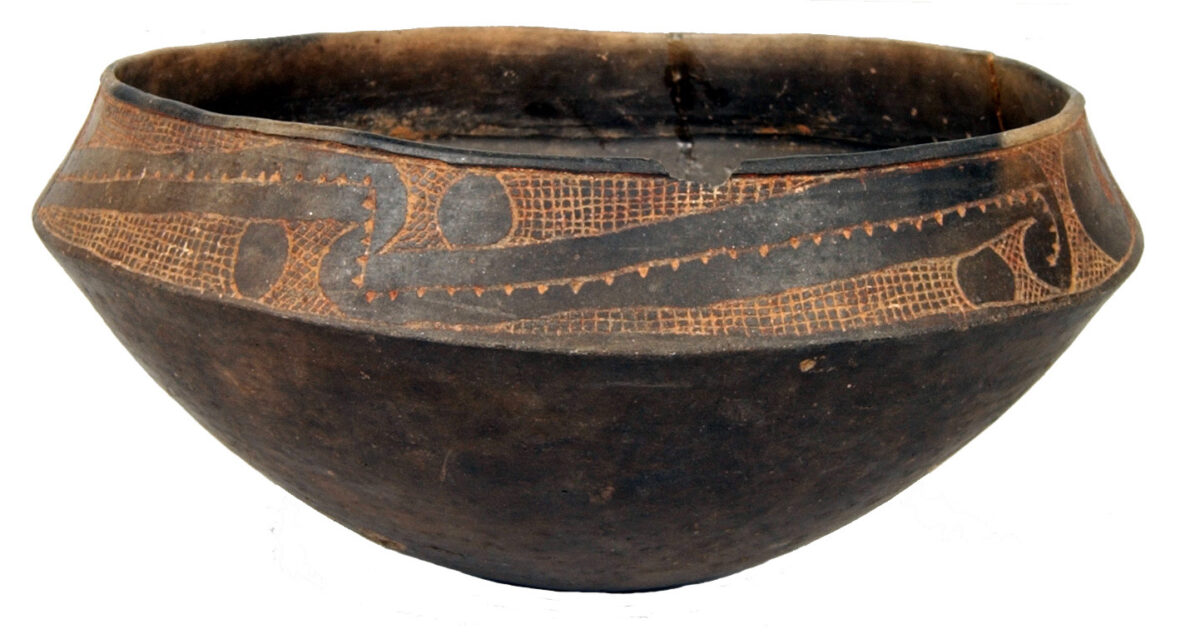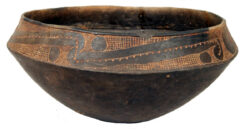Mississippi Period
People of the Plaquemine, Caddo, and Mississippian cultures lived in Louisiana between 300 and 800 years ago during a time known as the Mississippi period.
This entry is 4th Grade level View Full Entry

Williamson Museum, Northwestern State University
Caddo Culture Carinated Bowl.
What was life like during the Mississippi period?
The fourth and final period that historians and archaeologists use to describe Native cultures in the southeastern United States and Louisiana prior to and during the early period of European colonization is called the Mississippi period. The Mississippi period lasted 500 years, from 1200 to 1700 CE. During this time, Native people’s main source of food was maize agriculture (growing corn), though they still hunted, fished, and gathered wild plants like their ancestors. They also built massive ceremonial sites with monuments and large houses for their leaders, who were increasingly buried with elaborate and exotic possessions to show their high status.
Who lived in Louisiana during the Mississippi period?
According to archaeologists, people living in Louisiana during this time belong to three different cultures: Caddo culture, Plaquemine culture, and Mississippian culture. Mississippian culture did not begin in Louisiana. It developed near modern-day St. Louis, Missouri, around 1000 CE, at least two centuries before the Plaquemine culture. As the ideas tied to Mississippian culture spread, many people living in Louisiana took up corn agriculture. Mississippian styles of pottery, made with ground-up mussel shells mixed into clay, were introduced, along with new lifestyles and beliefs. Mississippians from outside of Louisiana also traveled to the area, meeting people whose ancestors had lived in Louisiana for many centuries. Archaeologists and historians call one of these groups Plaquemine culture.
Plaquemine culture is named after the town of Plaquemine in Iberville Parish. Plaquemine culture sites are found throughout South Louisiana as well as central and northeastern parts of the state. Medora in West Baton Rouge Parish is one of the most well-known Plaquemine sites. It had two platform mounds, with a house or temple built on top of one of the mounds. Plaquemine sites are recognized by specific artifacts like pottery fragments with a distinctive brushed decoration.
In northeast and southeast Louisiana, Mississippians influenced the local Plaquemine culture through pottery styles and the exchange of ideas. Some Plaquemine sites have Mississippian pottery styles and designs. In other regions, local Plaquemine communities maintained their own characteristic ways of life. For example, we don’t find high-status items buried among their dead. For some Plaquemine communities, especially those in Louisiana’s wetlands, the maize agriculture introduced by Mississippians was not as attractive as hunting, fishing, and harvesting wild foods like persimmon and pecan. Many Plaquemine people did not adopt corn agriculture until around 1400 CE. People with different cultures, beliefs, and ways of life interacted and intermarried, choosing between tradition and change. The Chitimacha Tribe of Louisiana are among the modern-day descendants of people who practiced Plaquemine culture.
The Caddo people are another group that lived in Louisiana during the Mississippi period. The Caddos were around well before the Mississippi period. Their distinctive artifacts and sites in northwest Louisiana have been dated to at least 900 CE. Most precolonial Native cultures, such as the Mississippian and Plaquemine cultures, have names that archaeologists assigned to their artifacts and sites. However, the name “Caddo” comes from the word Kadohadacho (meaning real, or proper, Caddo). Besides the Kadohadacho, the Caddos included groups known as the Hasinai and the Natchitoches. The Natchitoches lived in Louisiana along the Red River while other Caddos lived in northeast Texas, southeast Oklahoma, and southwest Arkansas.
A good example of a Caddo site is the ceremonial center and village known as Mounds Plantation, which is in northern Caddo Parish. The site dates to just before the Mississippi period. Excavations on one of the mounds during the early 1960s uncovered several deep tombs. Leaders were buried in these tombs, along with other individuals that might have been sacrificed, possibly family members, servants, or enslaved people. Over time, the Caddos followed the Mississippian tradition of burying objects, some exquisitely made of exotic stone, in the tombs.
Many archaeologists think Caddo pottery is the most accomplished pottery made during this period. Some Caddo pottery is highly polished and covered in intricate designs with symbols that indicate ties with the Mississippian culture. The Caddos also made high-quality stone axes (called celts), chipped-stone ceremonial blades, arrowheads, and strong bows.
The Caddos raised corn, beans, and squash. They also hunted, fished, and collected wild plants like nuts, persimmon, wild grapes, and berries. Deer, fish, and turtles were very important in the Caddo diet, but they also ate rabbit, squirrel, and turkey.
Caddo people in Arkansas and Texas were visited by a Spanish expedition in the 1540s, but the Caddos in Louisiana avoided direct contact with Europeans until French explorer Henri de Tonti visited northwest Louisiana in 1690. Nevertheless, diseases brought by Europeans caused horrible epidemics and a decline in the Native population throughout Louisiana. Possibly because of their long-term success as traders, Caddo culture survived. Some Caddos continue to live in Louisiana today.
